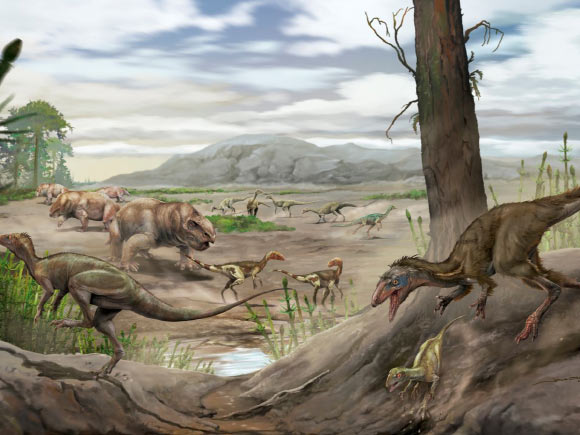A new genus and species of theropod dinosaur being named Anteavis crurilongus has been described by a team of paleontologists from the Universidad Nacional de San Juan, the Museo Argentino de Ciencias Naturales ‘Bernardino Rivadavia,’ the University of Birmingham, CONICET and CIGEOBIO.
Anteavis crurilongus roamed Earth during the Carnian age of the Late Triassic epoch, 231 to 226 million years ago.
This dinosaur was approximately 1.2 m (4 feet) in length and weighed about 8-9 kg.
The ancient species was an early-diverging theropod placed outside the dinosaur group Neotheropoda, but it had unexpectedly derived features previously thought to be exclusive to that group.
“It is one of the oldest and most primitive dinosaurs known so far,” said Dr. Ricardo Martínez from the Universidad Nacional de San Juan and his colleagues.
“The early diversification of dinosaurs produced a major ecological change in the terrestrial ecosystems, culminating with tetrapod assemblages dominated in abundance by dinosaurs by the Triassic/Jurassic boundary, 201 million years ago.”
“Therefore, studying the initial diversification of dinosaurs is crucial to understand the establishment of Mesozoic assemblages.”
“However, the lack of stratigraphically continuous fossil data in the few geological units that preserve the oldest known dinosaurs (233-227 million years ago) obscures our understanding of this initial diversification.”
The paleontologists unearthed the fossilized remains of Anteavis crurilongus — a partial skeleton and skull — in the Ischigualasto Formation in northwest Argentina in 2014.
“There are very few places in the world that preserve such ancient and well-preserved fossils,” Dr. Martinez said.
“One of them is the Santa Maria Formation in the Brazilian state of Rio Grande do Sul; the other is the Ischigualasto Formation.”
Anteavis crurilongus lived in a warm and arid savanna about two million years after the Carnian pluvial episode.
“We show that dinosaur diversity and abundance in the Ischigualasto Formation were higher than previously recognized, particularly among small herbivores (<30 kg) and medium-sized (30-200 kg) predators,” the researchers said.
“This diversification occurred in Ischigualasto during a climatic shift to semi-arid conditions, but the return of more humid conditions resulted in a gap in the dinosaur record that started at around 229 million years ago.”
“Only 15 million years later, in the middle Norian age, the dinosaur record recovered its abundance and diversity in the basin, but now it was characterized by larger-bodied species.”
“Our findings demonstrate an early dinosaur diversification probably punctuated by a climate-driven faunal turnover in, at least, southwestern Pangea.”
A paper about the discovery was published this week in the journal Nature Ecology & Evolution.
_____
R.N. Martínez et al. A Carnian theropod with unexpectedly derived features during the first dinosaur radiation. Nat Ecol Evol, published online October 14, 2025; doi: 10.1038/s41559-025-02868-4








